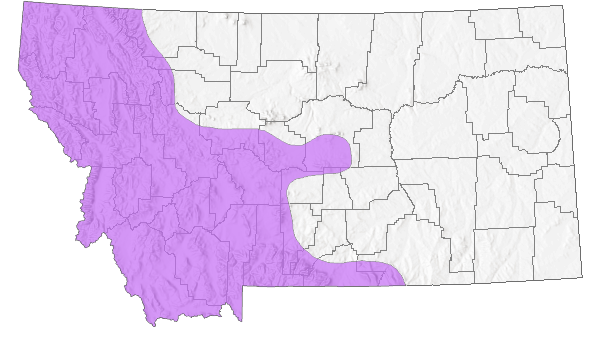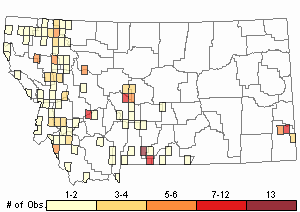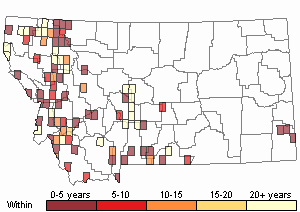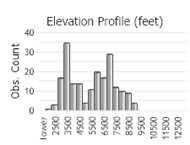View in other NatureServe Network Field Guides
NatureServe
Montana
Utah
Wyoming
Idaho
Wisconsin
British Columbia
South Carolina
Yukon
California
New York
Hooded Ladies'-tresses - Spiranthes romanzoffiana
Other Names:
Hooded Lady's-tresses, Hooded Ladies-tresses
Native Species
Global Rank:
G5
State Rank:
S4
(see State Rank Reason below)
C-value:
6
Agency Status
USFWS:
USFS:
BLM:
External Links
State Rank Reason (see State Rank above)
Spiranthes romanzoffiana is scattered throughout western and portions of central Montana. Populations are relatively more common in comparison with its relative Spiranthes diluvialis and can be found in montane wet meadows, fens, and other mesic sites in the mountains of Montana.
General Description
PLANTS: A long-lived perennial plant, usually with a single stem, 5-40 cm tall, that grows from a thickened, tuberous root. Source: Lesica et al. 2012.
LEAVES: Narrowly oblanceolate, 3-15 cm long. Leaves are longest at their base, becoming shorter towards the inflorescence, and persist during flowering. Source: Lesica et al. 2012.
INFLORESCENCE: A terminal bracteate spike that is viscid, 2-10 cm long. Few to many, white or ivory flowers spiral around the upper stem, in a 3- or 4-rank pattern. Bracts are 7-12 cm long. Flowers are perpendicular to the stem, 6-merous, but there is merger in each of the uppermost petals or sepals and lowermost petals or sepals. Upper, lower, and lateral sepals are greenish. Upper sepals and upper petals are crowded together, united below, and form a forward-pointing hood. Lateral sepals are fused for at least half their length but have tips that spread apart. Lip petal is 7-11 mm long with a dilated, reflexed tip. Lip petal is constricted like a violin at its mid-way point. Hood formed by petals and sepals is 5-10 mm long. Source: Lesica et al. 2012.
The genus
Spiranthes comes from the Greek words of "speira" which means coiled and "anthos" which means flower. They refer to the spirally arranged inflorescence.
The common name of "Ladies'-tresses" refers to the inflorescence which resembles the braided locks of hair worn by women (USFWS 1990).
NATIONAL LINK - IDENTIFICATIONGo Orchids-North American Orchid Conservation Center
Phenology
Ute Ladies'-tresses flowers from June to September across its range (Sheviak and Brown in Flora of North America (FNA)).
Diagnostic Characteristics
Hooded Ladies'-tresses -
Spiranthes romanzoffiana*Flowers: Flowers in spike are densely crowded. Flowers spiral on the spike creating 3- or 4- ranks or columns. Flowers grow more upright.
*Upper Sepals/Petals: Sepals are partially fused and united with the petals, forming a true hood over the stamens and pistil. Hood is shorter, 5-10 mm long.
*Lip Petal: Partially hidden by the hood, making it difficult to see when viewed from the side. Petal is constricted in the middle, like a violin, and has an acute tip. Spur is absent.
*Habitat: Wet meadows, fens, and occasionally in grasslands, from valleys to subalpine.
Ute Ladies'-tresses -
Spiranthes diluvialis, Federally Threatened, SOC
*Inflorescence: Flowers in the spike are spaced further apart, less dense. Flowers spiral on the spike creating 3-ranks or columns.
*Upper Sepals/Petals: Form a less distinct hood and are more long and slender. Both are separated for most of their length, connecting only at their base. Hood is 7-12 mm long.
*Lip Petal: Clearly visible when viewed from the side. Petal is not constricted in the middle and has a blunt tip. Spur is absent.
*Habitat: Wet, calcareous, riparian meadows in valleys.
Bog Orchids -
Platanthera species
*Flowers: Arranged in a spike-like raceme, but do not spiral around the stalk.
*Lip petal: Forms a downward pointing spur.
*Leaves: Either basal or leafy along entire stem. Those on the stem are sheathing, alternately-arranged, and whither during flowering.
Rein Orchids -
Piperia species
*Flowers: Arranged in a spike-like raceme, but do not spiral around the stalk.
*Lip petal: Forms a downward pointing spur.
*Leaves: Basal and on the lower third of the stem. Those on the stem are sheathing and may be arranged opposite or alternate.
Species Range
Montana Range
Range Descriptions

 Native
Native
Range Comments
Alaska to Newfoundland, south to California, New Mexico, Nebraska, Iowa, and New York (Lesica et al. 2012).
Observations in Montana Natural Heritage Program Database
Number of Observations: 300
(Click on the following maps and charts to see full sized version)
Map Help and Descriptions
Relative Density

Recency



 (Observations spanning multiple months or years are excluded from time charts)
(Observations spanning multiple months or years are excluded from time charts)
Habitat
Wet meadows, fens, occasionally moist grasslands from the valley to subalpine zones in Montana (Lesica et al. 2012).
Ecology
In grasslands, plants produce above ground stems only in wet years in Montana (Lesica et al. 2012).
POLLINATORS The following animal species have been reported as pollinators of this plant species or its genus where their geographic ranges overlap:
Bombus fervidus (Colla and Dumesh 2010).
Reproductive Characteristics
Plants are long-lived herbaceous, perennials that reproduce only by seed.
FLOWERS
Stamens: 1 or 2, fertile, and unite with the style of the pistil to form a column (Lesica et al. 2012). Pistil: 1 style and a 3-celled, inferior ovary.
FRUITS
An ovoid capsule, 6-10 mm long containing many tiny seeds (Lesica et al. 2012).
Management
Stewardship Responsibility
References
- Literature Cited AboveLegend:
 View Online Publication
View Online Publication Colla, S.R. and S. Dumesh. 2010. The bumble bees of southern Ontario: notes on natural history and distribution. Journal of the Entomological Society of Ontario 141:39-68.
Colla, S.R. and S. Dumesh. 2010. The bumble bees of southern Ontario: notes on natural history and distribution. Journal of the Entomological Society of Ontario 141:39-68. Flora of North America Editorial Committee. 2002. Flora of North America North of Mexico. Vol. 26. Magnoliophyta: Liliidae: Liliales and Orchidales. New York, NY: Oxford Univ. Press. xxvi + 723 pp.
Flora of North America Editorial Committee. 2002. Flora of North America North of Mexico. Vol. 26. Magnoliophyta: Liliidae: Liliales and Orchidales. New York, NY: Oxford Univ. Press. xxvi + 723 pp. Lesica, P., M.T. Lavin, and P.F. Stickney. 2012. Manual of Montana Vascular Plants. Fort Worth, TX: BRIT Press. viii + 771 p.
Lesica, P., M.T. Lavin, and P.F. Stickney. 2012. Manual of Montana Vascular Plants. Fort Worth, TX: BRIT Press. viii + 771 p. U.S. Fish and Wildlife Service. 1990. Proposal to list the plant Spiranthes diluvialis (Ute ladies'-tresses) as a threatened species. Federal Register 55(219): 47347-47350.
U.S. Fish and Wildlife Service. 1990. Proposal to list the plant Spiranthes diluvialis (Ute ladies'-tresses) as a threatened species. Federal Register 55(219): 47347-47350.
- Additional ReferencesLegend:
 View Online Publication
View Online Publication
Do you know of a citation we're missing? Brackley, F.E. 1985. The Orchids of New Hampshire. Rhodora 87:1-117. A85BRA01PAUS
Brackley, F.E. 1985. The Orchids of New Hampshire. Rhodora 87:1-117. A85BRA01PAUS Cope, M.G. 1992. Distribution, habitat selection and survival of transplanted Columbian Sharp-tailed Grouse (Tympanuchus phasianellus columbianus) in the Tobacco Valley, Montana. M.Sc. Thesis. Bozeman, Montana: Montana State University. 60 p.
Cope, M.G. 1992. Distribution, habitat selection and survival of transplanted Columbian Sharp-tailed Grouse (Tympanuchus phasianellus columbianus) in the Tobacco Valley, Montana. M.Sc. Thesis. Bozeman, Montana: Montana State University. 60 p. Correll, D.S. 1950. Native Orchids of North America, North of Mexico. Chronica Botanica Company, Waltham, Mass. USA. B50COR01PAUS
Correll, D.S. 1950. Native Orchids of North America, North of Mexico. Chronica Botanica Company, Waltham, Mass. USA. B50COR01PAUS DuBois, K.L. 1979. An inventory of the avifauna in the Long Pines of Southeastern Montana. M.Sc. Thesis. Bozeman, MT: Montana State University. 113 p.
DuBois, K.L. 1979. An inventory of the avifauna in the Long Pines of Southeastern Montana. M.Sc. Thesis. Bozeman, MT: Montana State University. 113 p. Fernald, M. L. 1950. Gray's manual of botany. Eighth edition. A handbook of the flowering plants and ferns of the central and northeastern United States and Adjacent Canada. American Book Co., New York.
Fernald, M. L. 1950. Gray's manual of botany. Eighth edition. A handbook of the flowering plants and ferns of the central and northeastern United States and Adjacent Canada. American Book Co., New York. Fultz, J.E. 2005. Effects of shelterwood management on flower-visiting insects and their floral resources. M.Sc. Thesis. Bozeman, MT: Montana State University. 163 p.
Fultz, J.E. 2005. Effects of shelterwood management on flower-visiting insects and their floral resources. M.Sc. Thesis. Bozeman, MT: Montana State University. 163 p. Gleason, H.A. 1952. New Britton & Brown. Illustrated Flora. Lancaster Press Inc. Lancaster, Pa. B52GLE01PAUS
Gleason, H.A. 1952. New Britton & Brown. Illustrated Flora. Lancaster Press Inc. Lancaster, Pa. B52GLE01PAUS Henry, L.K., W.E. Buker and D.L. Pearth. 1975. Western Pennsylvania Orchids. Castanea 40 (2):93-171.
Henry, L.K., W.E. Buker and D.L. Pearth. 1975. Western Pennsylvania Orchids. Castanea 40 (2):93-171. Jones, W. W. 1901. Preliminary flora of Gallatin County. M.S. Thesis. Bozeman, MT: Montana State College. 78 pp.
Jones, W. W. 1901. Preliminary flora of Gallatin County. M.S. Thesis. Bozeman, MT: Montana State College. 78 pp. Law, D.J. 1999. A comparison of water table dynamics and soil texture under black cottonwood recent alluvial bar, beaked sedge, and Geyer's/Drummond's willow communities. M.Sc. Thesis. Bozeman, MT: Montana State University. 68 p.
Law, D.J. 1999. A comparison of water table dynamics and soil texture under black cottonwood recent alluvial bar, beaked sedge, and Geyer's/Drummond's willow communities. M.Sc. Thesis. Bozeman, MT: Montana State University. 68 p. Lesica, P., M.T. Lavin, and P.F. Stickney. 2022. Manual of Montana Vascular Plants, Second Edition. Fort Worth, TX: BRIT Press. viii + 779 p.
Lesica, P., M.T. Lavin, and P.F. Stickney. 2022. Manual of Montana Vascular Plants, Second Edition. Fort Worth, TX: BRIT Press. viii + 779 p. Luer, C. A. 1975. The native orchids of the United States and Canada. The New York Botanical Garden, Bronx, New York. 361 pp.
Luer, C. A. 1975. The native orchids of the United States and Canada. The New York Botanical Garden, Bronx, New York. 361 pp. McCance, R.M., Jr., and J.F. Burns, eds. 1984. Ohio endangered and threatened vascular plants: Abstracts of state-listed taxa. Division Natural Areas and Preserves, Ohio Dept. Natural Resources, Columbus. 635 pp.
McCance, R.M., Jr., and J.F. Burns, eds. 1984. Ohio endangered and threatened vascular plants: Abstracts of state-listed taxa. Division Natural Areas and Preserves, Ohio Dept. Natural Resources, Columbus. 635 pp. Tuinstra, K. E. 1967. Vegetation of the floodplains and first terraces of Rock Creek near Red Lodge, Montana. Ph.D dissertation. Montana State University, Bozeman 110 pp.
Tuinstra, K. E. 1967. Vegetation of the floodplains and first terraces of Rock Creek near Red Lodge, Montana. Ph.D dissertation. Montana State University, Bozeman 110 pp. Von Chamisso, Ludolf Adelbert. 1836. De Plantis in Expeditione Speculatoria Romanzoffiana observatis rationem dicunt, in Linnaea i-x, 1826-1836. Vol 3, part 1, pages 25-35. Orchid. arcticae. B36VON01PAUS.
Von Chamisso, Ludolf Adelbert. 1836. De Plantis in Expeditione Speculatoria Romanzoffiana observatis rationem dicunt, in Linnaea i-x, 1826-1836. Vol 3, part 1, pages 25-35. Orchid. arcticae. B36VON01PAUS. Voss, E.G. 1972. Michigan Flora Part I. Kingsport Press, Bloomfield Hills, Mich. B72VOS01PAUS
Voss, E.G. 1972. Michigan Flora Part I. Kingsport Press, Bloomfield Hills, Mich. B72VOS01PAUS
- Web Search Engines for Articles on "Hooded Ladies'-tresses"





